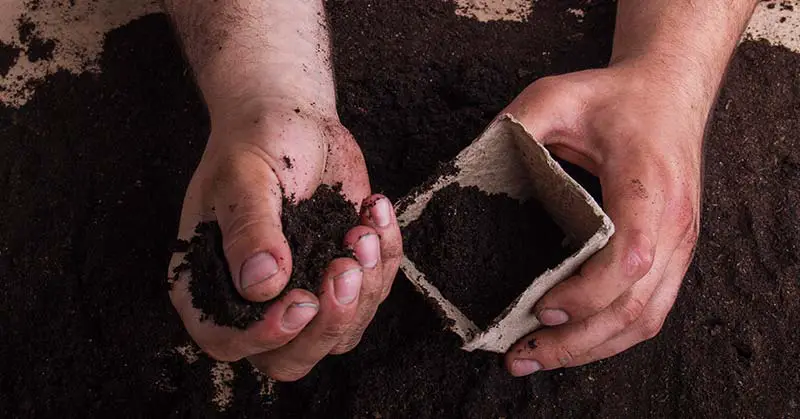Accelerated Composting: Efficient Soil Enrichment
Accelerated composting, as the name suggests, is a method of composting that speeds up this process. The decomposition process can be expedited through specific techniques to produce compost in weeks rather than months or even a year.
The underlying principle is to create optimal conditions that encourage the rapid reproduction and activity of the microorganisms responsible for breaking down organic matter.
Accelerated composting involves controlling several vital factors influencing the decomposition rate, including the carbon-to-nitrogen ratio (C: N ratio), the size of composting materials, moisture, aeration, and temperature.
By carefully managing these factors, we can provide the ideal environment for microorganisms to thrive and work faster.
For instance, we can provide an optimal diet for the microbes by ensuring the composting materials have a proper C: N ratio (about 25-30:1). Chopping materials into smaller pieces increases the surface area available for microbial activity, which can also hasten the composting process.
In addition, regular turning or aerating of the compost pile provides the oxygen that aerobic microbes need to function efficiently. Moisture is also essential, as microbes require water to live and move within the compost pile.
Lastly, heat, a byproduct of microbial activity, should be managed as it can accelerate decomposition and kill microbes if the temperature gets too high.
The benefits of this approach are multifold: it produces compost faster for use in gardening, reduces the volume of organic waste that would otherwise end up in landfills, and cuts down on the greenhouse gases produced by organic waste decomposition in an anaerobic (oxygen-lacking) landfill environment.
Through this composting method, we can create a sustainable cycle of waste reduction and soil enrichment, harnessing the power of nature to nourish our gardens and help our planet.

Comparison Between Traditional and Accelerated Composting
Traditional composting and accelerated composting are both essential processes for breaking down organic waste into nutrient-rich soil, but they differ significantly in terms of time, method, and management. Here’s a comparison of the two:
Time Frame:
Traditional composting is a passive process that can take six months to 2 years, depending on the climate, the type of materials used, and how often the compost pile is turned.
Accelerated composting, on the other hand, can produce compost in as little as 2 to 6 weeks. This is due to the active management and optimization of conditions that promote faster decomposition.
Method:
Traditional composting usually involves creating a compost pile or bin and adding organic waste materials as they become available. It typically uses cold composting methods, which don’t require turning or monitoring temperature.
Accelerated composting uses methods like hot composting, Bokashi, or vermicomposting. However, these methods need more active involvement, such as maintaining a specific carbon-to-nitrogen ratio, turning the compost regularly, and sometimes adding composting accelerators or inoculants to boost microbial activity.
Management:
Traditional composting is low-maintenance and ideal for a simple, hands-off approach. It’s more of a “set it and forget it” method.
Accelerated composting requires more effort and knowledge, as it involves actively managing the compost pile’s conditions. This includes ensuring proper aeration, maintaining moisture levels, and monitoring temperature.
Volume and Space:
Traditional composting might require larger space due to the more extended composting period and larger volume of waste.
Accelerated composting is more space-efficient because the process reduces the volume of organic waste faster. This makes it a suitable choice for those with limited space.
End Product:
Both methods produce nutrient-rich compost that improves soil structure, moisture retention, and nutrient content. However, accelerated composting allows for more frequent production and use of compost due to its shorter timeline.
Why Choose Accelerated Composting?
It can offer various benefits, from environmental gains to personal convenience and even economic savings. Here are some reasons why accelerated composting can be an excellent choice:
1. Environmental Benefits:
Reduction in Greenhouse Gas Emissions: When organic waste decomposes in landfills, it produces methane, a potent greenhouse gas. Accelerated composting helps reduce methane emissions by efficiently composting organic waste at home.
Conservation of Landfill Space: By composting organic waste at home, less waste ends up in the landfill, preserving valuable space.
2. Personal Benefits:
Faster Production for Garden Use: Accelerated composting allows you to create nutrient-rich compost in a shorter time, making it an ideal choice if you need compost quickly for your garden.
Less Labor-Intensive Over Time: While it may require some effort to set up and maintain initially, once the compost pile is established and functioning well, it can require less work than the frequent turning required in traditional composting.
3. Economic Benefits:
Reducing Waste Disposal Costs: Composting at home can reduce the volume of trash you need to dispose of, potentially lowering your waste disposal costs, especially in areas where waste disposal is charged by volume or weight.
Creation of a Sellable Byproduct: If you produce more compost than you can use, you could sell it to local gardeners, farmers, or garden centers, turning your waste into profit.
Methods of Accelerated Composting
Accelerated composting can be achieved through various methods, each with its advantages and considerations. Here are some popular methods:
Hot Composting:
This method uses a mix of green (nitrogen-rich) and brown (carbon-rich) materials in a compost pile that is regularly turned to maintain a high temperature.
This heat aids the rapid breakdown of materials. As a result, the process can produce usable compost within a few weeks to a few months.
Bokashi Composting:
Bokashi is a Japanese method that uses a particular bran inoculated with beneficial microbes to ferment organic waste. It’s a two-step process where waste is first fermented in a sealed bucket; then, the semi-composted waste is buried in the soil to complete the composting process.
This method is excellent for small spaces and can handle materials like meat and dairy that are only sometimes composted.
Vermicomposting:
This method uses worms, usually red wigglers, to consume organic waste and convert it into nutrient-rich worm castings. It’s a fast, efficient method suitable for indoor or outdoor composting. Worm castings can be harvested as little as 2-3 months after starting.
Composting with Accelerators or Starters:
Accelerators, also known as compost starters, can be added to your compost pile to speed up decomposition. They contain a mixture of microorganisms, enzymes, and sometimes nutrients that help kick-start composting.
Step-by-Step Guide to Accelerated Composting
Getting started with accelerated composting might seem daunting, but following these steps, you can create a compost pile that will produce nutrient-rich compost in a fraction of the time.
This guide uses the hot composting method as an example, but the steps can be applied to other methods with some adjustments.
Choosing the Right Method for Your Needs:
Consider the amount of space you have, the types and volume of organic waste you generate, and how quickly you need compost. Hot composting is suitable if you have outdoor space and want to compost quickly.
Bokashi or vermicomposting could be more suitable for indoor composting or small spaces.
Gathering the Necessary Materials:
You’ll need a balance of green (nitrogen-rich) and brown (carbon-rich) materials. Greens can include vegetable scraps, coffee grounds, or fresh grass clippings.
Browns can be leaves, straw, or shredded newspaper. Aim for a ratio of about 2:1 browns to greens by volume.
You’ll also need a compost bin or designated area for your compost pile. Compost bins can help contain the compost and make it easier to turn.
Starting Your Compost Pile:
Begin with a layer of brown at the bottom for aeration and drainage. Then add a layer of greens, followed by another layer of browns. Repeat this until your bin is full or your pile is about 3 feet high. Please ensure each layer is wet (like a wrung-out sponge) as you add it. If you have a compost accelerator, you can add it according to the product’s instructions.
Maintaining Your Compost Pile:
Turn your compost pile every few days to ensure adequate aeration. This will also help distribute heat evenly throughout the pile. Keep an eye on the moisture level—it should stay as wet as a wrung-out sponge. If it’s too dry, add water. If it’s too wet, add more browns.
How to Know When Your Compost is Ready:
Your compost is ready when it looks like rich, dark soil and has a pleasant, earthy smell. The original materials should be unrecognizable. This can happen in as little as 2-6 weeks with hot composting, but the timing will depend on the method and conditions.
Using Your Compost:
Use your finished compost as a soil amendment in your garden. It can be mixed into garden soil or used as a mulch. It contains nutrients and beneficial microbes, so your plants will love it!
The Future of Accelerated Composting
The future of this composting method looks promising and exciting. As the world continues to grapple with environmental challenges, this method of waste management and soil enrichment is expected to gain even more traction. Here are a few ways the future of accelerated composting might unfold:
Technological Advancements:
New technologies could revolutionize how we approach accelerated composting. For example, we could see the development of home composting units that automate the process, making it easier and more efficient.
There could also be advancements in compost accelerators that enhance the speed and effectiveness of composting.
Larger Scale Implementation:
Composting is predominantly a small-scale household practice or a part of organic farming operations. However, the future may shift with more municipalities, cities, or countries implementing large-scale accelerated composting programs.
This could drastically reduce the amount of organic waste going to landfills and lower greenhouse gas emissions.
Education and Awareness:
As people become more aware of the environmental benefits of composting, we could see a rise in the number of households participating in composting practices.
Schools and educational institutions could also incorporate composting into their curriculum, fostering a new generation of enthusiasts.
Policy and Regulation:
As the benefits of composting are more widely recognized, it may influence policy and regulations. For example, governments could provide incentives for composting or even mandate composting of suitable organic waste.
Innovations in Composting Methods:
The future might see new methods of accelerated composting, which could be more efficient or suitable for different types of waste or living situations.
This could include advancements in indoor composting methods or methods that can handle various waste materials.
Final Thoughts
Accelerated composting represents a vital tool for sustainable waste management and healthier soils. Its capacity to rapidly transform organic waste into nutrient-rich compost makes it an attractive option for gardeners, farmers, and environmentally-conscious individuals.
The potential benefits are substantial, whether through traditional hot composting, innovative Bokashi, or vermicomposting.
As we look to the future, the growth and development of accelerated composting methods could play a pivotal role in our collective effort to reduce greenhouse gas emissions, minimize landfill use, and foster a more sustainable relationship with our planet.



